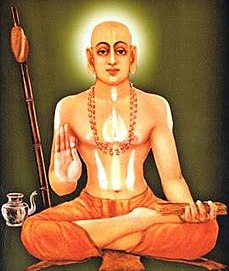Satyanidhi Tirtha
Satyanidhi Tirtha (d. 1660) was a Hindu philosopher, scholar and saint. He served as the pontiff of Shri Uttaradi Math from 1638–1660. He was the 19th in succession from Madhvacharya. Satyanidhi Tirtha ruled the pontificate with a remarkable distinction. His life was a saga of supreme spiritual achievements.[1]
Sir Satyanidhi Tirtha | |
|---|---|
| Personal | |
| Born | Kauligi Raghupathyacharya Present day Bijapur district, Karnataka |
| Resting place | Kurnool, Andhra Pradesh |
| Religion | Hinduism |
| Order | Vedanta (Uttaradi Math) |
| Philosophy | Dvaita, Vaishnavism |
| Religious career | |
| Guru | Satyavrata Tirtha |
| Successor | Satyanatha Tirtha |
Disciples
| |
| Part of a series on |
| Dvaita |
|---|
 |
|
Literature
|
|
|
Holy places |
| Hinduism portal |
Life
Most of the information about his life is derived from two hagiographies: one is Gurucarya, a hagiological work on the Pontiffs of the Uttaradi Math and the other one is Satyanidhivilasa by Sarkara Srinivasa.[2][1] Born as Kaulagi Raghupathyacharya into Deshastha Rigvedi Brahmin family of scholars to Purushothamacharya and Satyadevi in Puntamba, Maharashtra. He studied Vyakarana and Shastras under Kumbhari Vasudevacharya. He was ordained and was made the pontiff of Uttaradi Math in 1638.[2] He served as pontiff of mutt for 21 years and 9 months. After his death in 1660, his mortal remains were enshrined in the mutt at Kurnool. He was succeeded by Satyanatha Tirtha.[3]
Works
Satyanidhi Tirtha authored three works consisting of commentaries on the works of Vyasatirtha and a few hymns. They are as follows:[4]
- Bhedojjivana, a gloss on Bhedojjivana of Vyasatirtha
- Vayu Bharathi Stotra, a praise hymn on Vayu and Bharathi.
- Vishnu Sahasranama Vyakhyana, a commentary on Vishnu Sahasranama.
Legacy
Satyanidhi Tirtha has been eulogised by Sarkara Srinivasa in his contemporaneous kavya Satyanidhivilasa, a kavya in honor of Satyanidhi in 8 cantos.[4][5] His disciple Satyanatha Tirtha sets forth the Purvapaksa and Siddhanta views under each adhikarana, and offers criticisms on the former in accordance with the views of his teacher Satyanidhi Tirtha, in his work Abhinava Chandrika.[2][6]
References
- Sharma 2000, p. 194.
- Sharma 2000, p. 497.
- Dagens 1984, p. 535.
- Sharma 2000, p. 496.
- Glasenapp 1992, p. 239.
- Sharma 2000, p. 447.
Bibliography
- Sharma, B. N. Krishnamurti (2000). A History of the Dvaita School of Vedānta and Its Literature, Vol 1. 3rd Edition. Motilal Banarsidass (2008 Reprint). ISBN 978-8120815759.CS1 maint: ref=harv (link)
- Dagens, Bruno (1984). Entre Alampur et Śrīśailam: recherches archéologiques en Andhra Pradesh, Part 1. Institut franc̜ais dʼindologie.CS1 maint: ref=harv (link)
- Glasenapp, Helmuth von (1992). Madhva's Philosophy of the Viṣṇu Faith. Dvaita Vedanta Studies and Research Foundation.CS1 maint: ref=harv (link)
- Dasgupta, Surendranath (1922). A History of Indian Philosophy, Vol 4. Motilal Banarsidass. ISBN 978-8120804159.CS1 maint: ref=harv (link)
- Devadevan, Manu V. (2016). A Prehistory of Hinduism. Walter de Gruyter GmbH & Co KG. ISBN 978-3110517378.CS1 maint: ref=harv (link)